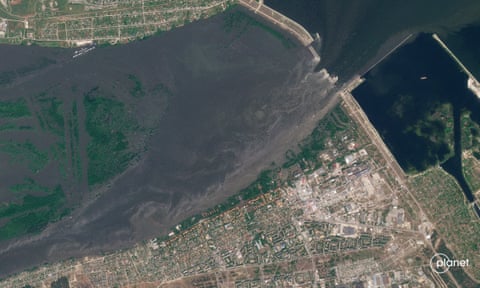The destruction of the Nova Kakhovka dam has led to fears that a depleted reservoir will leave three critical regions in Ukraine’s bread basket without a key water supply.
This has led to warnings about the region and wider world’s food supply, with Ukraine accounting for 40% of global trade in sunflower meal, 35% of sunflower oil, and 5% of wheat, barley and corn exports.
A series of canals run from the Kakhovka reservoir, all of which help irrigate swathes of agricultural land in southern Ukraine. If the reservoir dries up, this water supply will be reduced.
The most significant of these canals are the North Crimean and Kakhovsky canals, which run from just north of the broken dam.
The North Crimean canal supplies water to western Kherson before flowing down to Crimea. Its entrance is just before the dam and satellite imagery from 6 June already shows increased greenery within its reservoir – a sign of the water level decreasing.
The Kakhovsky canal irrigates most of the Kherson region’s fields before entering Zaporizhzhia.
Dnipro region is also supported by the Dnipro-Kryvyi Rih canal which runs north of the Kakhovka reservoir, while a separate canal system provides drinking water and irrigation to the city of Zaporizhzhia.
Satellite imagery of the area directly south of the reservoir, around these canals, shows mile upon mile of agricultural land. The circular formations are caused by a centre-pivot irrigation system that waters crops with equipment that rotates around a pivot.
Ukraine’s most important crops are corn, wheat, sunflower seed and barley. All of these yields are already down by at least a fifth in 2023-24, according to the US Department of Agriculture.
There are fears that declining levels in the Kakhovka reservoir will mean less water feeding through to the network of canals used to irrigate these crops.
With the exception of corn, which has its biggest yields in northern Ukraine, the other three crops are centred in the south.
Dnipro and Zaporizhzhia are some of the most important regions for wheat and both rely on canals that run from the reservoir. Dnipro is similarly important for sunflower seed.
While Odesa and Mykolaiv have the biggest yields for barley, Dnipro, Zaporizhzhia and Kherson are all still big producers of this crop.
Already images from the village of Marianske in Dnipro, taken on 7 June, show how reservoir levels have fallen.

The Ukrainian agrarian and food ministry has warned that agricultural land in these regions could be so heavily affected that they could turn into “deserts”.
“The terrorist act at the Kakhovskaya HPP [hydropower plant] has left 94% of irrigation systems in Kherson region, 74% in Zaporizhzhia, and 30% in Dnipropetrovsk without a source of water,” the ministry said in a statement. “The destruction of the Kakhovskaya HPP will mean that the fields in the south of Ukraine may turn into deserts as early as next year.”
